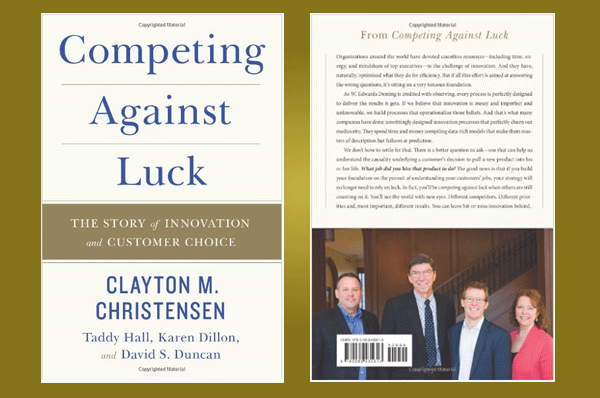Clayton M. Christensen, Karen Dillon , Taddy Hall, David S. Duncan : Competing Against Luck: THE STORY of INNOVATION and CUSTOMER CHOICE
Hardcover: 288 pages
Publisher: HarperBusiness; 1 edition (October 4, 2016)
Language: English
ISBN-10: 0062435612
ISBN-13: 978-0062435613
Product Dimensions: 6 x 1 x 9 inches
Being in the ‘Decade of Innovation’, this is yet another remarkable read on Innovation by Clayton Christensen and his co authors. The name of the book ‘Competing Against Luck’ caught my eye, as that is the reality in which we all are living. It is an engaging blend of actual success stories and ways to implement the ‘Job theory’ given in a simple and easy to read language. It would be useful for both first time entrepreneurs, intrapreneurs and established organizations struggling to survive in the current environment. The guiding theme of this book is on reducing the struggle for entrepreneurs and established businesses in today’s world by focusing on understanding where and how to find the right opportunities to innovate and capitalize on them.
Christensen defines a Job as ‘the progress that a person is trying to make in a particular circumstance’. Thus what a customer seeks through a product or service is a job. This will help understand the reason behind anyone making choices and that should be the guiding factor of an innovation. The focus of this book is not on how to make a good product, but how to help the customer make progress in the job one seeks.
The book has a very definitive structure, wherein the first section describes the Jobs Theory, the second section describes how the Jobs Theory can be applied, while the third section gives examples of Jobs to be done in organizations.
Christensen, defines ‘Jobs Theory’ to expound why asking the right questions is so essential for sustenance. The same management team which leads a company to success is blamed once the company stumbles. Companies have fallen owing to other competitors bringing out cheaper and more convenient options or sometimes luck. Job theory explains how a company can innovate and create products that customers would prefer to buy. Thus the emphasis is on understanding ‘why’ of their behavior and what job helped them make progress rather than the ‘what’ or ‘how’. It cites various examples that include Uber and Unilever to highlight this point. It reiterates that though disruption leads to innovation, disruption does not suggest ‘how’ a company can innovate or find new opportunities or what customers prefer to buy.
In the second section of the book, Christensen and his co founders go on to present various techniques to hunt for ‘Jobs’ or rather hunt for clues about where to innovate. These techniques are very intuitive and well researched with good examples. They give a good starting point for people with an entrepreneurial mind set looking for a viable opportunity. Once an opportunity has been recognized, Christensen also insists on understanding the ‘emotional dimension’ of the product/service. He carefully explains how Todd Dunn, director of innovation in a healthcare organization, who primarily works on innovating how patient care and experience can be improved, got a better understanding about the tools and their utility for a doctor and patient, when he himself got admitted as patient due to a bad knee. Christensen also emphasizes that the experience that the customer derives from the product or service should be part of the solution to the job to make it successful.
Finally, the book gives valuable insights about what organizations must do in context of the ‘Job to be Done’. Taking the emphasis on customer experience forward Christensen highlights the need for differentiation of the product and requirement of the right processes in an organization. He defines various benefits that organizations can enjoy if jobs are clearly defined by using various examples like Unilever’s color changing soap for children aimed to kill germs. Thus Christensen questions the assumption that luck plays a role in innovation.
Overall it is a good read with valuable insights for organizations struggling to understand their customers as well as first time entrepreneurs hunting for an opportunity. Most of the examples cited are those where Jobs theory has been tried and tested and has been successful. That makes this book a MUST READ for SUCCESS!!!



